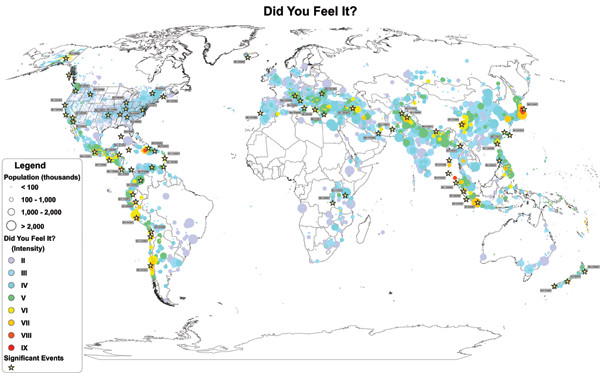
by Mary Caperton Morton Thursday, July 10, 2014

Intensity surveys help geologists study earthquakes. This map compiles all responses to the U.S. Geological Survey's Did You Feel It? survey between 1994 and 2012. Credit: USGS
Intensity scales like the Modified Mercalli scale, used in the U.S., and the European Macroseismic scale measure the strength of shaking produced by an earthquake at a certain location, as determined from surveys assessing the effects on people, structures and the natural environment. For example, a II on the Modified Mercalli scale is: “Felt only by a few persons at rest, especially on upper floors of buildings,” whereas a V is “felt by nearly everyone; many awakened. Some dishes, windows broken. Unstable objects overturned. Pendulum clocks may stop.”
“Instruments record a lot of useful and precise data, but they are very expensive both to set up and maintain,” says Paola Sbarra of the National Institute of Geophysics and Volcanology in Rome, Italy, and lead author of the new study, published in Seismological Research Letters. “But people’s responses to ground shaking, when averaged over a large number of samples, can be a very good indicator of the level of ground motion,” he says — despite the fact that scientists have to rely on people’s reported experiences with no way to verify the results.
Intensity surveys typically include questions like, “Was it difficult to stand or walk?” and “Did any furniture or appliances slide, topple over or become displaced?” The Modified Mercalli and European Macroseismic scales consider location as the strongest indicator for defining intensity. To assess which factors most influenced people’s perception of ground shaking, Sbarra and colleagues analyzed responses submitted to Hai sentito il terremoto? The team focused on two variables: a person’s activity during a quake and his or her location.
After examining 250,000 reports, Sbarra and his team found that people who said they were in motion — walking or riding in a car, for example — during an earthquake had the least reliable rates of perception, either magnifying or masking the degree of shaking, regardless of whether they were outside, on the ground floor or on the top floor of a building. The authors did not systematically investigate why motion might warp survey responses, but the decreased accuracy could be due to physical reasons, such as difficulty maintaining balance when walking, or psychological, given that being at rest could be more calming during an earthquake, Sbarra says.
The study’s results are interesting, but not surprising, says John Boatwright, a geologist at the USGS Earthquake Science Center in Menlo Park, Calif., who was not involved with the new research. Still, “this is a very useful study” because although the influence of activity on people’s perceptions of shaking “is a hypothesis that [scientists] have been aware of for awhile,” Boatwright says, “nobody has tried to look at it in a systematic way until now.”
Similar studies looking at the Did You Feel It? survey have yet to be done, Boatwright says, though the Did You Feel It? survey does make some attempt to account for people’s activity with questions similar to the Italian version, such as, “What was your physical situation during the earthquake?” and a drop-down menu of responses such as: inside, outside, in a moving vehicle, in a stopped vehicle or other, with a space for more detailed answers.
“We try to keep the survey simple, but sometimes people’s experiences fall through the cracks in the questionnaire,” Boatwright says. The questions haven’t changed much since the survey went online in the late 1990s, he says. “I’d like to see a few more questions and some more options in the damages menu.”
Sbarra agrees, adding that “this work also highlights the need to ask more detailed questions on the questionnaire about a person’s situation.” In addition, given their results, Sbarra and colleagues suggest the criteria of the European Macroseismic scale be changed to reflect the importance of activity, instead of placing most of the emphasis on location.
© 2008-2021. All rights reserved. Any copying, redistribution or retransmission of any of the contents of this service without the expressed written permission of the American Geosciences Institute is expressly prohibited. Click here for all copyright requests.